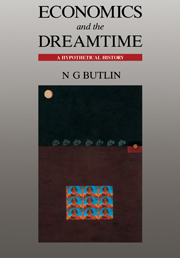Book contents
- Frontmatter
- Contents
- Preface
- Acknowledgements
- Figures
- Maps
- Tables
- Introduction
- Part I The palaeoeconomic history of Aboriginal migration
- 1 Introduction
- 2 Conventional views and alternative approaches
- 3 Non-Malthusian issues: pathways and innovations
- 4 Scarcity possibilities in Aboriginal migration
- 5 Some possible migration scenarios
- 6 A synthesis
- Part II Development, structure and function of Aboriginal economy
- Part III Disease, economics and demography
- Part IV The establishment of a bridgehead economy: 1788–1810
- Part V The takeover process: 1788–1850
- Bibliography
- Appendix 1 Preliminary model/checklist of Aboriginal migration to Australia
- Appendix 2 NOAA depth contour maps
- Index
5 - Some possible migration scenarios
Published online by Cambridge University Press: 06 July 2010
- Frontmatter
- Contents
- Preface
- Acknowledgements
- Figures
- Maps
- Tables
- Introduction
- Part I The palaeoeconomic history of Aboriginal migration
- 1 Introduction
- 2 Conventional views and alternative approaches
- 3 Non-Malthusian issues: pathways and innovations
- 4 Scarcity possibilities in Aboriginal migration
- 5 Some possible migration scenarios
- 6 A synthesis
- Part II Development, structure and function of Aboriginal economy
- Part III Disease, economics and demography
- Part IV The establishment of a bridgehead economy: 1788–1810
- Part V The takeover process: 1788–1850
- Bibliography
- Appendix 1 Preliminary model/checklist of Aboriginal migration to Australia
- Appendix 2 NOAA depth contour maps
- Index
Summary
A variety of ice age models has been attempted in non-economic areas. Climatologists, meteorologists, oceanographers, biogeographers, earth scientists, geneticists and others have made massive attempts to try to stimulate a variety of issues during the ice age, either globally or for some major area of the world (e.g. Bryson and Swain, 1981; Bryson and Murray, 1977; Cline, 1981; Gates, 1976; Kutzbach, 1981; Peterson et al., 1979; Walker and Sun Xiangjun, nd; Williamson and Barry, 1974). Unfortunately, little of this bears on island or mainland South-east Asia. Moreover, most of it is directed towards the climax conditions of about 17,000 BP and has only marginal bearing on much of the period relevant to the specific human adaptation over time that took the form of migration into island South-east Asia and to Australia/New Guinea. Certainly, there is no economics in any of the available modelling.
A first basic condition for any palaeoeconomic history is that so far there is no evidence within Australia of markedly different types of human beings (granted the distinction between some gracile and robust people). On the other hand, only a very tiny fraction (perhaps 0.00002%) of ever-dying persons in Australia have been identified (Pardoe, 1988) and a much smaller fraction (perhaps 0.0000003%) actually studied. Nevertheless, this constraint is accepted. So far as ‘push’ factors go, one must look for processes that, in effect, extruded essentially similar people out of mainland into island South-east Asia and on to Australia.
- Type
- Chapter
- Information
- Economics and the DreamtimeA Hypothetical History, pp. 42 - 48Publisher: Cambridge University PressPrint publication year: 1993



